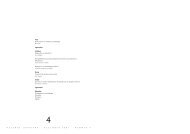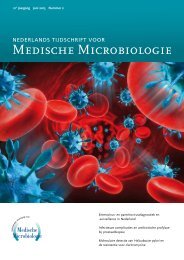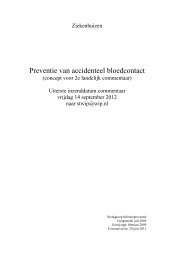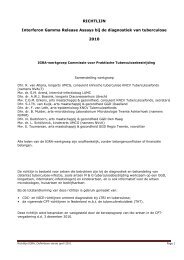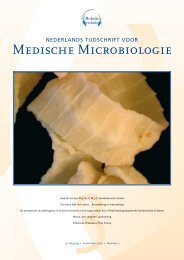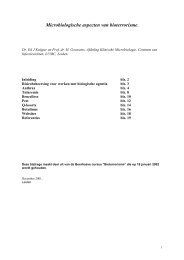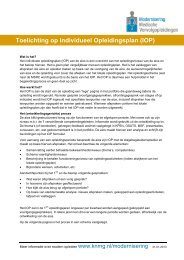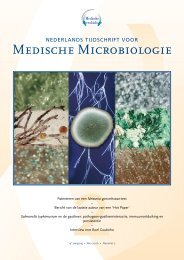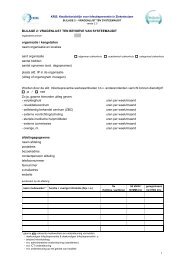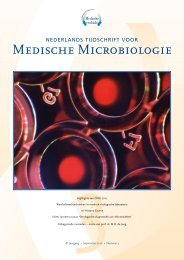Thema: Diabetes mellitus en infectieziekten Het ... - NVMM
Thema: Diabetes mellitus en infectieziekten Het ... - NVMM
Thema: Diabetes mellitus en infectieziekten Het ... - NVMM
- No tags were found...
Create successful ePaper yourself
Turn your PDF publications into a flip-book with our unique Google optimized e-Paper software.
egim<strong>en</strong>s above 30%. While pres<strong>en</strong>ted in the guidelineas being equal first choice options, in daily practice therewas a prefer<strong>en</strong>ce for some recomm<strong>en</strong>ded options and theavoidance of others.This study shows that in the dynamic field of continuouslychanging bacterial resistance rates regular real-lifeassessm<strong>en</strong>ts of recomm<strong>en</strong>ded treatm<strong>en</strong>t options ar<strong>en</strong>ecessary. The results <strong>en</strong>dorse specific recomm<strong>en</strong>dationsfor pati<strong>en</strong>ts with a urinary catheter in place.Evaluation of a tailored hepatitis B vaccinationprogram for injecting drug users in the NetherlandsA.T. Urbanus, P.M. van Beek, J.H.T.C van d<strong>en</strong> Kerkhof,A. Tim<strong>en</strong>C<strong>en</strong>tre for infectious Diseases (CIb) National Institute forPublic Health and the Environm<strong>en</strong>t (RIVM), Bilthov<strong>en</strong>Background: In 2002, the Netherlands introduced afree hepatitis B (HBV) vaccination program targeted atbehavioral risk groups (gay m<strong>en</strong>, sex workers and injectingdrug users – IDUs ) since universal vaccination was notcurr<strong>en</strong>t policy in the Netherlands yet. Here we evaluate theparticipation of IDUs in this program.Methods: Vaccination is giv<strong>en</strong> at 0, 1 and 6 months atthe public health services (PHS) or at outreach locations(e.g. methadone programs). Scre<strong>en</strong>ing of antiHBc isperformed along with the first vaccination. Wh<strong>en</strong> antiHBcis positive the vaccination schedule stops. Participation andcompliance are stimulated by the use of targeted media andvaccination is registered in an online tool.Results: From 2002-2011, 17,860 drug users (mean age 37,range 12-76) received at least one HBV vaccination. Overallcompliance with the second and third vaccination is 81%and 58% respectively. The number of IDUs decreasedfrom 3609 in 1999 to 1871 in 2008. Only 0.2% (3/1383)of the acute HBV infections where transmitted by IDU.It was estimated that 28% of the total IDU populationcompleted the vaccination schedule. In total 0.7% IDUswere diagnosed with chronic HBV-infection (HBsAgpositive) and 11.7% had ever acquired HBV-infection(antiHBc positive).Conclusion: The vaccination program for IDUs issuccessful; the number of acute HBV infections hasdecreased. Besides, the number of IDUs has decreased aswell. Therefore a collective vaccination program for thisgroup is not effici<strong>en</strong>t anymore. From 2013 vaccination ofIDUs is considered individual care.Mouth masks prev<strong>en</strong>t persist<strong>en</strong>t carriage of livestockassociatedMRSA in pig farmers: a prospective cohortstudyB.A.G.L. van Cleef 1,2,3 , B.H.B. van B<strong>en</strong>them 1 , M.F.Q.Kluytmans-van d<strong>en</strong> Bergh 3 , E. Verkade 2,3 , M. van Rij<strong>en</strong> 3 ,J.A.J.W. Kluytmans 2,3,41 C<strong>en</strong>tre for Infectious Disease Control Netherlands, RIVMNational Institute for Public Health and the Environm<strong>en</strong>t,Bilthov<strong>en</strong>, 2 Laboratory for Medical Microbiology andImmunology, St. Elisabeth Hospital, Tilburg, 3 Laboratory forMicrobiology and Infection Control, Amphia Hospital, Breda,4 Departm<strong>en</strong>t of Medical Microbiology and Infection Control,VU University Medical C<strong>en</strong>tre, AmsterdamSince 2005 pigs and veal calves have be<strong>en</strong> recognizedas a source for livestock-associated methicillin-resistantStaphylococcus aureus (LA-MRSA). Carriage rates in pigand veal farmers are very high (20-40%) compared tothe g<strong>en</strong>eral Dutch population (0.1%). The aim of thisprospective cohort study was to further elucidate thedynamics and determinants of LA-MRSA carriage inpig farmers. In total, 110 pig farmers from 50 Dutch pigfarms were included in the study. Nasal and pharyngealsamples and questionnaires were collected on 6 samplingmom<strong>en</strong>ts during a one-year follow-up period. The meanMRSA preval<strong>en</strong>ce per sampling mom<strong>en</strong>t was 63%, 38% ofpig farmers were persist<strong>en</strong>tly carrying MRSA. MethicillinsusceptibleStaphylococcus aureus (MSSA) nasal carriagewas a significant protective factor for the acquisitionof MRSA (preval<strong>en</strong>ce ratio (PR) 0.47, p-value 0.02).Multivariate analysis id<strong>en</strong>tified int<strong>en</strong>se pig contact, i.e.working in the stables for more than 40 hours per week(PR 1.89, p 0.01), and working with sows (PR 2.26, p 0.03),and being of medium age (40-49 years, PR 2.13, p 0.00) asindep<strong>en</strong>d<strong>en</strong>t risk factors for persist<strong>en</strong>t carriage of MRSA.The continuous use of a mouth mask wh<strong>en</strong> working in thestables was a statistically significant protective factor thatprev<strong>en</strong>ted 87% of persist<strong>en</strong>t MRSA carriage (PR 0.13, p0.02). This cohort study shows that MSSA carriage protectspig farmers from acquiring LA-MRSA and that using amouth mask during stable work prev<strong>en</strong>ts LA-MRSA tobecome persist<strong>en</strong>t. We recomm<strong>en</strong>d to perform interv<strong>en</strong>tionstudies on the use of mouth masks in pig farming.Livestock-associated MRSA in household membersof pig farmers: a prospective cohort studyB.A.G.L. van Cleef 1,2,3 , B.H.B. van B<strong>en</strong>them 1 , M.F.Q.Kluytmans-van d<strong>en</strong> Bergh 3 , E. Verkade 2,3 , M. van Rij<strong>en</strong> 3 ,J.A.J.W. Kluytmans 2,3,41 C<strong>en</strong>tre for Infectious Disease Control Netherlands, RIVMNational Institute for Public Health and the Environm<strong>en</strong>t,Bilthov<strong>en</strong>, 2 Laboratory for Medical Microbiology andImmunology, St. Elisabeth Hospital, Tilburg, 3 Laboratory forMicrobiology and Infection Control, Amphia Hospital, Breda,4 Departm<strong>en</strong>t of Medical Microbiology and Infection Control,VU University Medical C<strong>en</strong>tre, AmsterdamSince 2005 pigs and veal calves have be<strong>en</strong> recognizedas a source for livestock-associated methicillin-resistantStaphylococcus aureus (LA-MRSA). Reported preval<strong>en</strong>cesNed Tijdschr Med Microbiol 2012;20:nr4184



